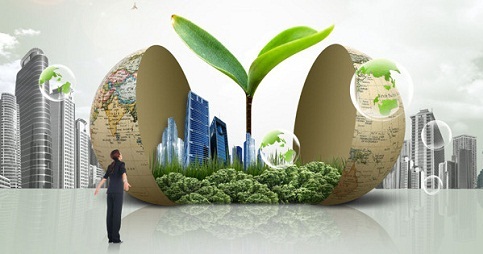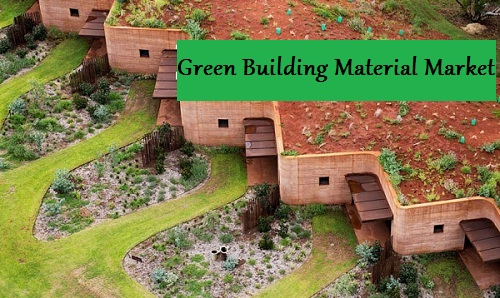Global green building materials market
Introduction
Though cost concerns, market barriers and lack of government policies encouraging green construction are some factors which hinder the growth of green building materials, continuous innovation and a rise in the growth of the building and construction sector provides great potential for market expansion.
Green building materials promote the conservation of non-renewable resources and reduce environmental impact associated with fabrication, processing, installation, transportation, disposal, and recycling.
They are employed in the construction industry to address environment challenges including climate change, natural resource depletion, atmospheric pollution, contamination of fresh water resources, and loss of biodiversity.
The emission reduction potential of green building materials, high asset value of green buildings, growth in public awareness, and an increase in client and market demand are the major factors that drive the green building materials market across the globe. Increasing concerns regarding energy prices, accelerating climate change, negative health impacts associated with building materials, and stormwater runoff polluting rivers and lakes have reinforced the need for green building construction in the residential sector.
DGNB, LEED, BREEAM, HQE, and EnergyStar are some of the certification systems that evaluate performance of the green buildings.
New low-rise and high residential buildings, retrofits of existing buildings, and new industrial buildings are the major areas where growth of green building materials is expected.
Exterior products accounted for more than one-third of the market in terms of revenue in 2015. Employment of green building exterior products in construction industry offers energy efficiency, durability, low maintenance, and operation cost and waste reduction over traditional construction techniques. The residential buildings segment holds the largest share by application in terms of revenue and is expected to grow at a CAGR of 11.2%.
Porter’s Five Forces Analysis
Green building employs pollution-free production technology and low-energy manufacturing processes, which helps control expenses and environmental hazards. The demand for raw materials used in green building materials market has increased considerably over the years, whereas the sources from which these raw materials are derived are limited in nature.
Market Dynamics:
Drivers:
Emission Reduction Potential of Green Building Materials
The building and construction sector accounts for more than two-thirds of total greenhouse gas emissions across the globe. Thus, there is a great potential for reducing greenhouse emissions by enhancing the energy efficiency of buildings and communities. Reductions in greenhouse emissions can be accomplished by the construction of new green buildings with low energy consumption and retrofitting of existing buildings.
Restraints:
Cost Concerns and Market Barriers
A wide variety of cost concerns and market barriers exist in the green building construction market including the “split incentive” barrier, i.e., owners of the houses don’t make effective investments in their properties as the occupants reap benefits from these investments and not the owners. A total of 40% of commercial buildings and 32% of households are rented or leased.
Top Winning Strategies:
To withstand competition, the key players in the global green construction materials industry have adopted different key business strategies, such as acquisitions, expansions, product launch, and collaboration.
Key findings of the Green Building Materials Market:
- Asia-Pacific is expected to continue to lead the market during the forecast period followed by Europe.
- Solar products market revenue is projected to grow with a high CAGR of 13.5% during the forecast period.
- Roofing is the fastest growing segment in green building exterior products registering a CAGR of 12.2% during the forecast period.
- Brazil accounts for three-fifths share in LAMEA green building materials market in 2015.
- India grows at a faster rate in Asia-Pacific green building materials market, registering a CAGR of 12.7% from 2016 to 2022.
- France accounts for 11.1% share in Europe green building materials market in 2015.
Related articles on Designing Buildings Wiki
Featured articles and news
One of the most impressive Victorian architects. Book review.
RTPI leader to become new CIOB Chief Executive Officer
Dr Victoria Hills MRTPI, FICE to take over after Caroline Gumble’s departure.
Social and affordable housing, a long term plan for delivery
The “Delivering a Decade of Renewal for Social and Affordable Housing” strategy sets out future path.
A change to adoptive architecture
Effects of global weather warming on architectural detailing, material choice and human interaction.
The proposed publicly owned and backed subsidiary of Homes England, to facilitate new homes.
How big is the problem and what can we do to mitigate the effects?
Overheating guidance and tools for building designers
A number of cool guides to help with the heat.
The UK's Modern Industrial Strategy: A 10 year plan
Previous consultation criticism, current key elements and general support with some persisting reservations.
Building Safety Regulator reforms
New roles, new staff and a new fast track service pave the way for a single construction regulator.
Architectural Technologist CPDs and Communications
CIAT CPD… and how you can do it!
Cooling centres and cool spaces
Managing extreme heat in cities by directing the public to places for heat stress relief and water sources.
Winter gardens: A brief history and warm variations
Extending the season with glass in different forms and terms.
Restoring Great Yarmouth's Winter Gardens
Transforming one of the least sustainable constructions imaginable.
Construction Skills Mission Board launch sector drive
Newly formed government and industry collaboration set strategy for recruiting an additional 100,000 construction workers a year.
New Architects Code comes into effect in September 2025
ARB Architects Code of Conduct and Practice available with ongoing consultation regarding guidance.
Welsh Skills Body (Medr) launches ambitious plan
The new skills body brings together funding and regulation of tertiary education and research for the devolved nation.
Paul Gandy FCIOB announced as next CIOB President
Former Tilbury Douglas CEO takes helm.
























